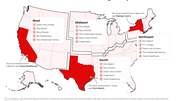Operations
How the restaurant industry will bounce back from COVID-19
Changing marketing tactics, upgrading sanitation tracking and scaling down menus are just a few things that restaurants are doing in order to stay in business and to attract investors.

June 22, 2020 by Jim Balis — Partner, CapitalSpring
After months of mass closures due to COVID-19, restaurants around the country are slowly preparing to reopen their doors and dining areas to customers. While this is giving many people hope that the economic shutdown is coming to an end, the process of bouncing back from this crisis is still complex and uncertain, especially in the restaurant industry.
With constantly changing state and federal regulations, differences in guidance from one market to the next, various sanitizing requirements and significant labor issues, there are no playbooks for recovering from this pandemic. These unique business challenges also include gauging how soon customers will return to restaurants and how their habits will change once the economy normalizes.
The capacity limitations and reopening phases are also being determined by individual state and local ordinances. For example, we have one restaurant location in our portfolio at CapitalSpring, which is currently allowed to open up at 25% of its capacity before moving to 50%, while the bar has to stay closed. Each restaurant is navigating this in real-time.
Solving the challenges
One challenge restaurant operators might not be thinking about is the fact that if they reopen at a lower capacity, they may not be able to negotiate with landlords or defer payments, which could create a financial challenge if they continue to struggle to bring in customers. For example, there are some restaurant operators that are concerned that people may no longer specifically travel to the city to go out and eat.
In terms of serving customers safely, contactless services are here to stay, in every way. In addition to the usual contactless methods, such as mobile ordering or curbside pick up, there are several techniques that restaurant owners may not consider immediately, such as installing plates at the bottom of bathroom doors so people can use their feet to open the door instead of touching the doorknob. Self-serving digital kiosks may also be a thing of the past as the focus shifts to apps that people can access from their own phones.
When it comes to marketing, the key will be not only making customers aware that the restaurant is open, but also communicating the strategies being implemented to keep everyone safe and satisfied. In addition, we're working with all of our portfolio investments to help them understand that off-premise services will be here to stay and how to create promotional materials around that. COVID-19 or not, the restaurant industry is pivoting toward online ordering and third-party delivery, so brands need to continue to nurture that revenue channel moving forward.
Now, for those in states that are closer to opening, many restaurants are creating a gradual promotions strategy in which they hold a soft opening on Monday instead of a weekend day. Others are simply putting a banner up outside of the restaurant or posting on social but are not holding any aggressive opening day plans.
For a safe workforce and an attractive consumer experience, the restaurant industry will also need to implement sanitation tracking. Brands will need to show that they're taking all of the necessary steps, not just claiming to be cleaner than ever. Whether it's taking the temperature of employees or asking questions before their shifts, restaurants need to make sure that the whole process is thoroughly documented. Technology can play a large role in that regard. Also, many restaurants are looking to invest in new ventilation systems in order to create healthy airflow in busier, enclosed areas.
When staff members start to enter the workforce, employees may need to be staggered. For example, one group can work Monday through Wednesday while the other group works Thursday through Sunday, and then they switch. That way, if one group becomes infected, it doesn't impact the other and operations can continue.
Lastly, in order to try to make sure that restaurants are being efficient with labor and food costs, it will be important to scale down larger menus a little bit to ensure that there is less preparation and less waste.
In terms of investment firms, there are going to be many new requirements for restaurants. For example, we want to make sure brands are moving to contactless services as much as possible, implementing new virtual strategies, sanitation tracking and more.
As restrictions begin to lift, consumers will be most drawn to restaurants that provide the best value and experience. Everything that affects the facility — from cleanliness to capacity planning — needs to contribute to a better dining experience. These factors, combined with the prioritization of off-premise ordering platforms and a robust response to the pandemic, will play an important role in the industry's ability to bounce back from this crisis.
The restaurants that sit around waiting for things to return to normal are not going to survive, but those who adjust to these new circumstances are going to be well-positioned to do great business when the COVID-19 crisis is behind us.












